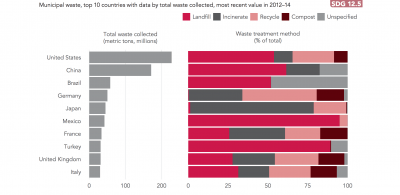The Atlas of Sustainability publishes data from around the world about environmental sustainability. Above is a chart of the top 10 countries with the most municipal waste, how much waste is collected, and where that waste goes. The United States is responsible for the most total waste collected, totaling over 200 million metric tons of municipal waste. Out of the waste collected in the United States, over 50% (52.7%), more than 100 million metric tons, ends up in landfills in the year 2014. 12.8% of waste in the United States was incinerated. In the year 2014, only 25.7% of waste was recycled in the United States, and only 8.7% of waste was composted.
When waste ends up incinerated or in landfills, it can have negative environmental impacts. Landfill waste is responsible for greenhouse gas emissions of both carbon dioxide and methane. When waste is burned, these greenhouse gases are also emitted into the air. In addition to air pollution, landfills also account for groundwater pollution. When it rains, hazardous chemicals dissolve and collect at the bottom of landfills. These chemicals dissolve into the ground, polluting the ground and soil.
When we recycle, we save waste from ending up in these landfill facilities and are able combat environmental damage. In order to reduce our negative environmental impact, Americans should make an increased effort to dispose of their lifestyle waste through recycling or composting. This way of disposal is far more environmentally friendly, and not very difficult to practice.



To be honest, I believe that a huge issue with our waste problem is that people don’t care—and they are just too lazy to do it properly. However, like you have mentioned, it is not difficult to recycle, and it is extremely better for the environment. Something that should be more popular in our everyday lives is composting. Composting is so easy; it is letting organic material decompose to enrich soil. It is quite simple, just take materials that you throw in the trash extremely often, such as fruits/vegetable peels, eggshells, coffee grounds, etc., and collect them separately, so they can decompose and be reintroduced into the environment. This, along with recycling, would help the landfill waste problems in America.
I am amazed the huge amount of waste that is incinerated in Japan! It appears that over half of the waste was burned which makes me terribly sad about the quality of the air that the Japanese people are breathing in. I can’t help but think about how much better and different the quality of life would be in Japan if they recycled and/or composted the amount of trash that was incinerated. I hope that by 2018 there are regulations in place that are decreasing the amount of incinerated waste in Japan.
It is truly alarming how much trash our country generates and how little we do to utilize it. Instead, we continuously destroy our air and land. Landfills should never be used, yet we are always creating newer and large ones whenever we begin to run out of room. The harmful pollutants that they emit not only harm us but they hurt innocent animals, which is the saddest part of all. I think you’re right that humans should make more of an effort to improve their lifestyles and live with the thought of their children’s future in mind.
I’m super surprised by the chart you posted here, specifically because of the large amount of landfills Mexico is responsible for and how little composting really exists. For some reason I thought that compost was more popular but it is clear from this graph that there are little efforts being made to compost and recycle. The amount of incineration that occurs in Japan is shocking, detrimental, tragic, and frankly frightening considering how many toxins are emitted when waste is burned.